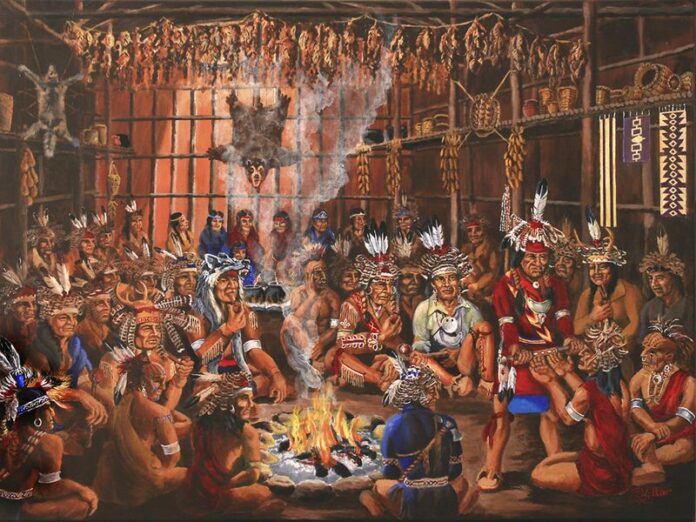Iroquois/Cherokee (Nephites)
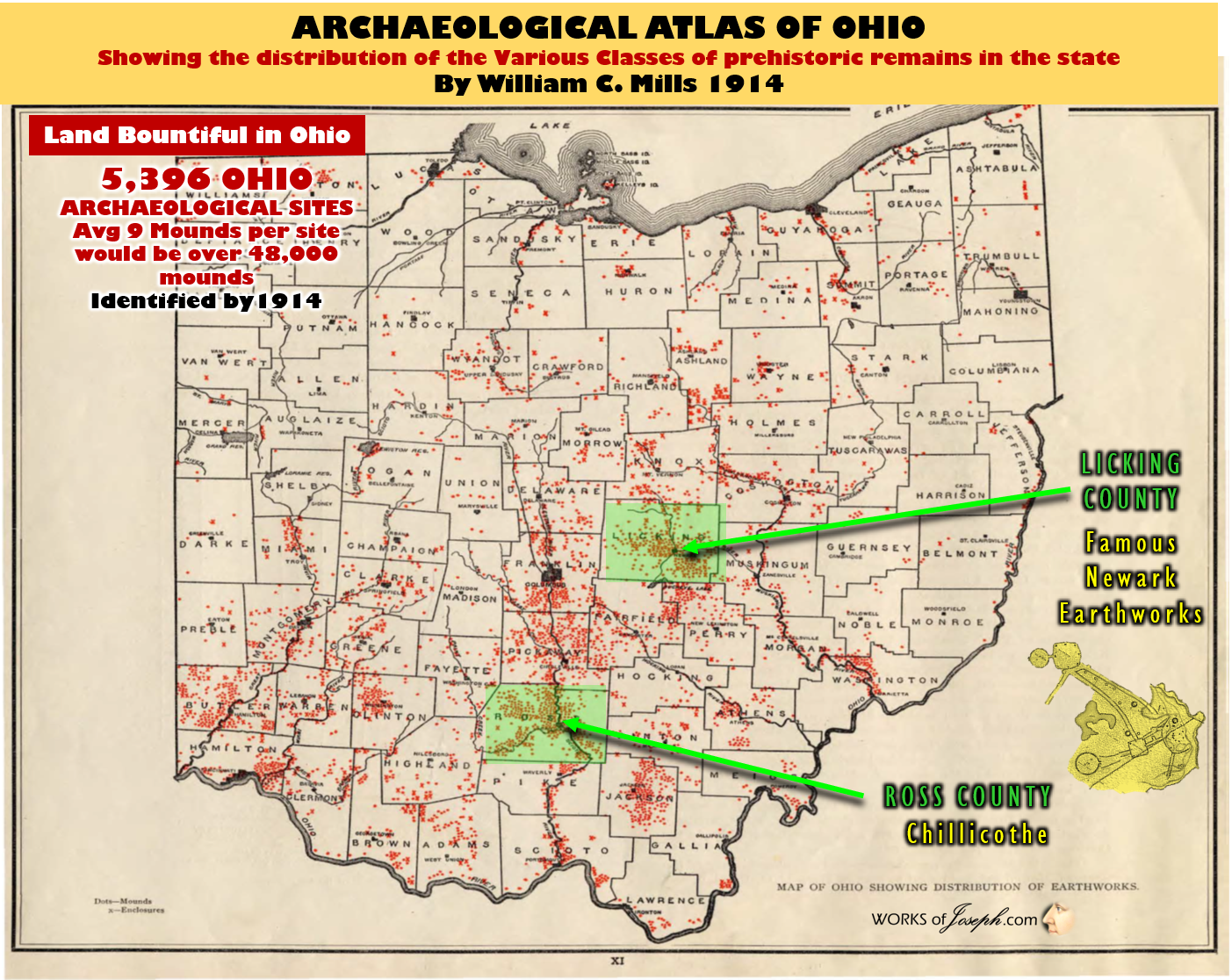 Just as the Book of Mormon tells the story of two main societies at war, Nephites vs. Lamanites, there are many instances historically of the same thing, as some are called the Iroquois vs. the Algonquian, or the Tallegwi (Iroquois) vs the Leni-Lape (Algonquian), or the Cherokee (Iroquois) vs the Delaware (Algonquian). These tribes seem to have always be at war with each other. Sometimes in history writers have used various names for the same group of people without understanding the differences. It seems possible that these historical tribes could be one in the same with ancient Book of Mormon Nephites and Lamanites.
Just as the Book of Mormon tells the story of two main societies at war, Nephites vs. Lamanites, there are many instances historically of the same thing, as some are called the Iroquois vs. the Algonquian, or the Tallegwi (Iroquois) vs the Leni-Lape (Algonquian), or the Cherokee (Iroquois) vs the Delaware (Algonquian). These tribes seem to have always be at war with each other. Sometimes in history writers have used various names for the same group of people without understanding the differences. It seems possible that these historical tribes could be one in the same with ancient Book of Mormon Nephites and Lamanites.
Elder James E. Talmage had a conversation with Professor William C. Mills the Ohio State Archaeologist in 1917. They both seem to have believed the nature of the ancient people in Ohio, were very similar to the Nephite and Lamanite story of the Book of Mormon.
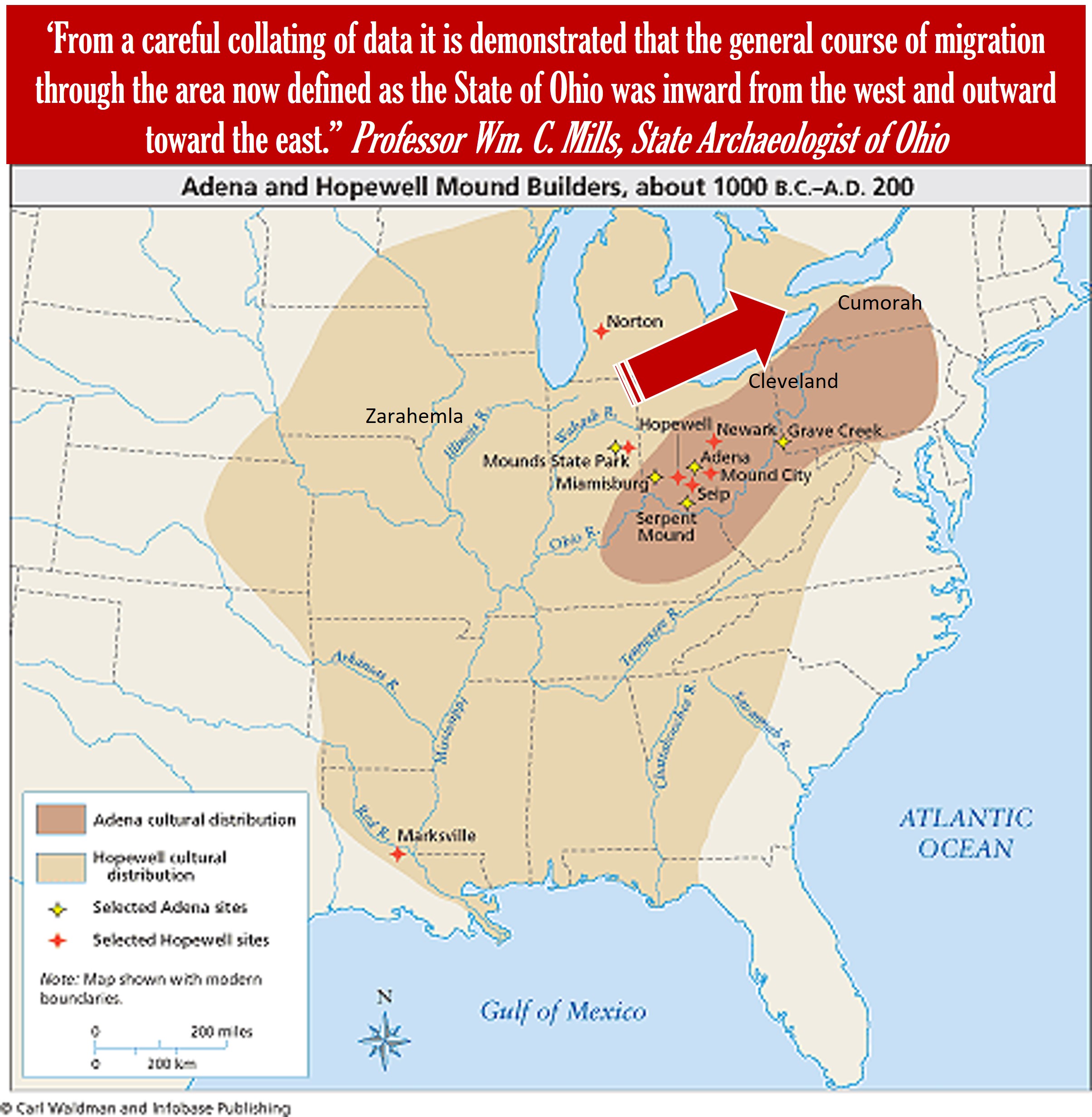 “I had a long and profitable consultation with Professor Wm. C. Mills, State Archaeologist of Ohio. He is continuing his splendid work of exploration in the Ohio mounds, and I went over with him again the remarkable agreement between his deductions and the Book of Mormon story. He has reached the following conclusions.” James E. Talmage 20 May 1917
“I had a long and profitable consultation with Professor Wm. C. Mills, State Archaeologist of Ohio. He is continuing his splendid work of exploration in the Ohio mounds, and I went over with him again the remarkable agreement between his deductions and the Book of Mormon story. He has reached the following conclusions.” James E. Talmage 20 May 1917
“The area now included within the political boundaries defining the State of Ohio was once inhabited by two distinct peoples, representing two cultures, a higher and a lower… These two classes were contemporaries; in other words, the higher and the lower culture represented distinct phases of development existing at one time and in contiguous sections and furnish in no sense an instance of evolution by which the lower culture was developed into the higher… There (are) two peoples or cultures…the lower culture was most commonly the assailing party, while the people of the higher type defended as best they could but in general fled… From a careful collating of data it is demonstrated that the general course of migration through the area now defined as the State of Ohio was inward from the west and outward toward the east.” Professor Wm. C. Mills, State Archaeologist of Ohio
Cherokee
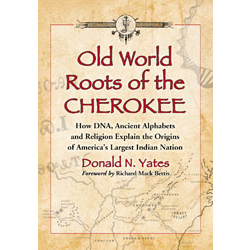
“Cherokee, North American Indians of Iroquoian lineage who constituted one of the largest politically integrated tribes at the time of European colonization of the Americas. Their name is derived from a Creek word meaning “people of different speech”; many prefer to be known as Keetoowah or Tsalagi. They are believed to have numbered some 22,500 individuals in 1650, and they controlled approximately 40,000 square miles (100,000 square km) of the Appalachian Mountains in parts of present-day Georgia, eastern Tennessee, and the western parts of what are now North Carolina and South Carolina.
Traditional Cherokee life and culture greatly resembled that of the Creek and other tribes of the Southeast. The Cherokee nation was composed of a confederacy of symbolically red (war) and white (peace) towns. The chiefs of individual red towns were subordinated to a supreme war chief, while the officials of individual white towns were under the supreme peace chief. The peace towns provided sanctuary for wrongdoers; war ceremonies were conducted in red towns.” Source
Great Spirit Appears to the Onondagas (Iroquois)
“On the authority of some older inhabitants of Onondaga, New York, it is stated that on a ledge of rocks, about a mile south of Jamesville, (Near Syracuse and Oneida Castle) is a place which used to be pointed out by the Indians as a spot where the Great Spirit once came down and sat and gave good advice to the chiefs of Onondagas. That there are the prints of his hands and his feet, left in the rocks, still to be seen. In the former years the Onondagas used annually to offer, at this place, tobacco and pipes, and to burn tobacco and herbs as a sacrifice to the Great Spirit, to conciliate his favor and which was a means of preventing diseases.” Author L. Taylor Hansen He Walked the Americas
The Great Law of Peace
 “Centuries before the creation of the United States and its Constitution, democracy had already taken root in North America—among a handful of Indigenous nations. Known as the Iroquois Confederacy, or Haudenosaunee, this league of nations emerged among five northeast woodlands tribes that had been plagued by wars of retribution and violence for many generations. The Haudenosaunee (“people of the longhouse”) originally included the Mohawk, Oneida, Onondaga, Cayuga and Seneca nations. In the 1700s, the Tuscarora became the sixth. Guided by the Great Law of Peace—their own constitution—this league came to jointly govern, while recognizing the sovereignty of each nation. The Great Law of Peace, credited largely to two visionary culture heroes, Hiawatha and Deganawida (a.k.a. “The Peacemaker”), established a model for federalism, separation of powers and participatory democracy that would inspire leaders like Benjamin Franklin and James Madison during the formation of the United States. It also conferred significant power and status to women in Iroquois culture…
“Centuries before the creation of the United States and its Constitution, democracy had already taken root in North America—among a handful of Indigenous nations. Known as the Iroquois Confederacy, or Haudenosaunee, this league of nations emerged among five northeast woodlands tribes that had been plagued by wars of retribution and violence for many generations. The Haudenosaunee (“people of the longhouse”) originally included the Mohawk, Oneida, Onondaga, Cayuga and Seneca nations. In the 1700s, the Tuscarora became the sixth. Guided by the Great Law of Peace—their own constitution—this league came to jointly govern, while recognizing the sovereignty of each nation. The Great Law of Peace, credited largely to two visionary culture heroes, Hiawatha and Deganawida (a.k.a. “The Peacemaker”), established a model for federalism, separation of powers and participatory democracy that would inspire leaders like Benjamin Franklin and James Madison during the formation of the United States. It also conferred significant power and status to women in Iroquois culture…
The ‘Words of Condolence,’ in Wampum
Hiawatha then gathered shells for the wampum strings and composed the “words of condolence” that would one day be central to the Great Law of Peace. “If I should see anyone in deep grief, I would take these shell strings from the pole and console them,” he said. “These strings would become words that would lift away the darkness with which they are covered.”
These words and others would eventually become the Great Law, codified in wampum shell strings for communication to future generations.
Hiawatha soon encountered members of the Oneida Nation, who had heard of him and of the dream that he would one day meet The Peacemaker. After sitting with them in council for seven days, Hiawatha traveled with their chief until he came to the Mohawks, where he would first encounter Deganawida.” https://www.history.com/news/iroquois-confederacy-hiawatha-peacemaker-great-law-of-peace
Condolence Ceremony

“The condolence ceremony or condolence council is a part of the Haudenosaunee Great Law of Peace. It governs succession to political offices after a leader dies. The ceremony is held in the community whose leader has died. Attendees are divided into two moieties: the clear-minded and the downcast or bereaved. The ceremony progresses through several stages, including a recitation of the Great Law. Through the ceremony, new leaders are appointed to replace those who have died. It was typically the first item on the agenda when a Haudenosaunee council met. Among other things, the ceremony recalls the Great Peacemaker’s condolence of Hiawatha and the “transformation” of Tadodaho from a state of confusion and disorder to a state of peace.” https://en.wikipedia.org/wiki/Condolence_ceremony

Great Law of Peace/Temple Ceremony
A great Native American friend of mine, indicated that he/she had not heard of the origin of the condolence ceremony, but “that today it is used by the Haudenosaunee in the official appointment of chief or clan representatives. Parts are also used to welcome guests.” On one occasion, my friend met one of the traditional Haudenosaunee chiefs in his office in Virginia. He informed my friend that were they in his territory, “he would take a piece of eagle down and clean my ears so that I could hear clearly, then he would wipe my forehead with soft doeskin so that I could think clearly and have the ‘Good Mind.’ Then he would use eagle down to clean my eyes so that I could see clearly. He would also use the doeskin to clean my lips and give me a drink of pure spring water to cleanse my mouth so that I would speak the truth. This was the traditional greeting before important meetings.” He then added: “The ‘Good Mind’ is more than just intelligence; it refers to a process of thinking that is highly moral and pure, all in accordance with the Great Law of Peace.” 2010 email from my Native friend.
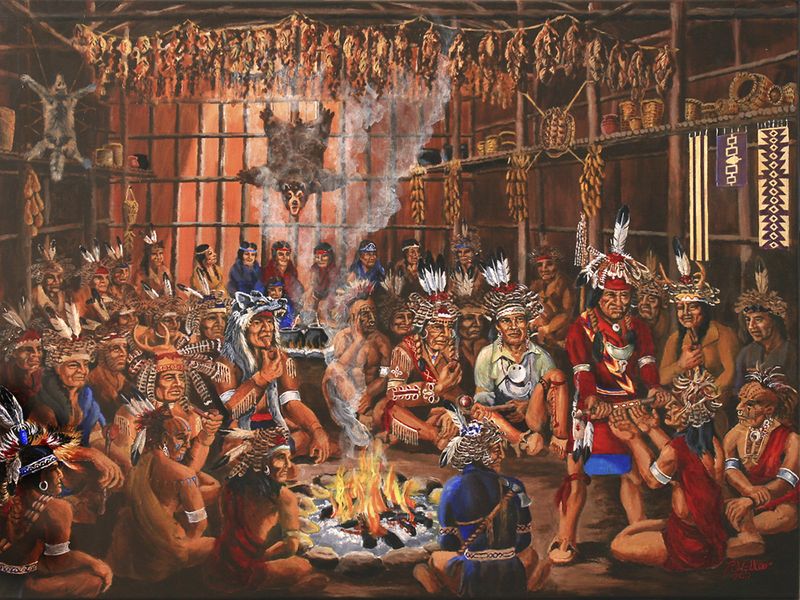
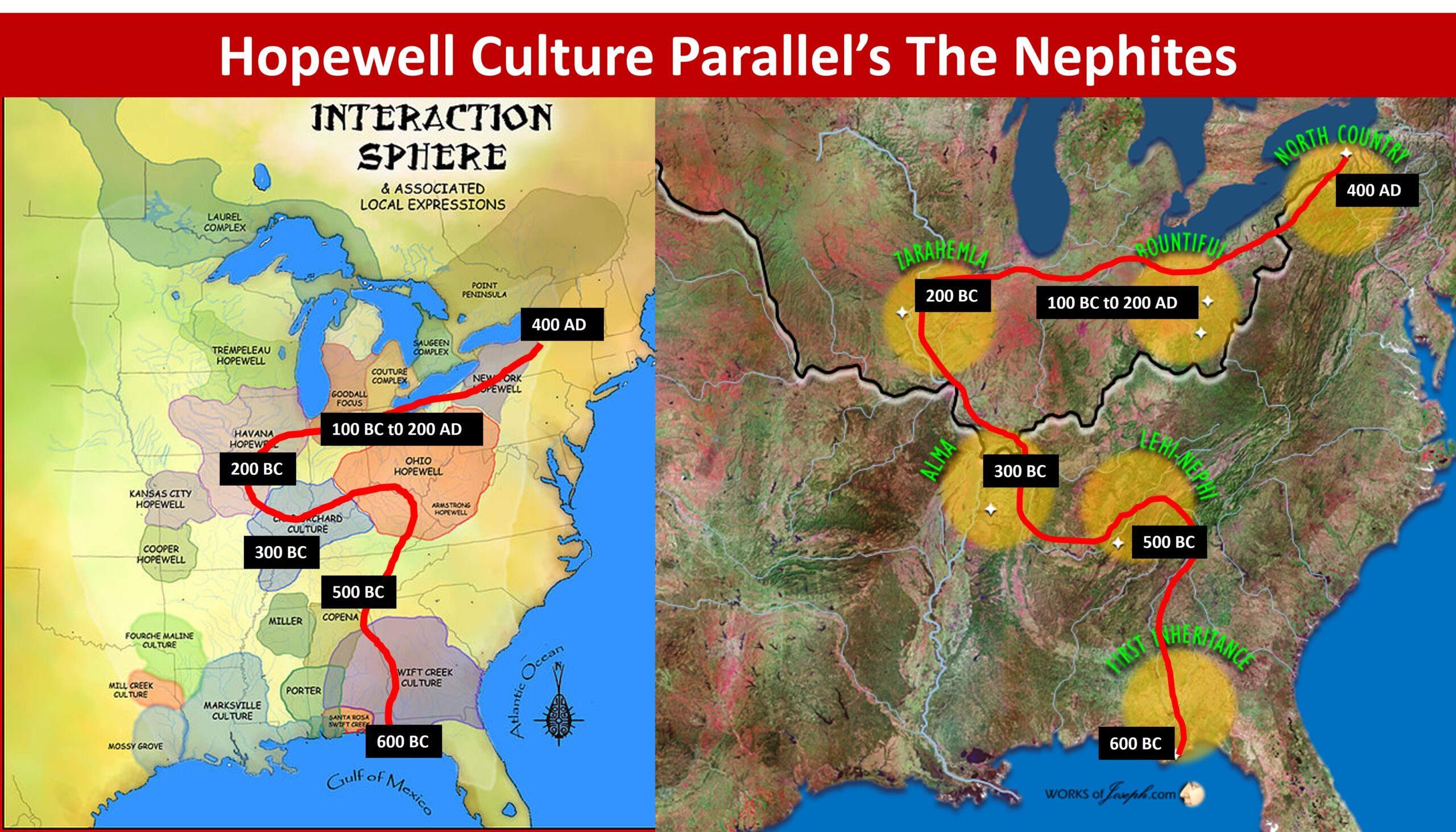
The symbolism is wonderful and seems to be a very important part of the Iroquois Nation of old, and the sacred Temple of today. It seems to me the Hopewell are the Nephites and the Adena are the Jaredites. It just makes sense.

